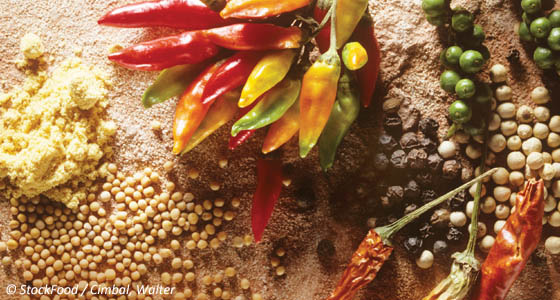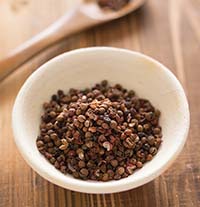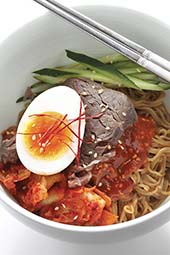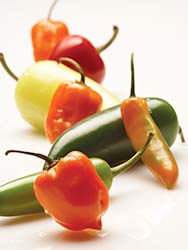Firing Up Product Development
Adventurous consumers are turning up the heat on chefs and products developers to formulate foods and beverages with bolder flavors and ranges of heat, from subtle to scorching.

The cuisines of Mexico, the Caribbean, Peru, Brazil, Thailand, India, and the American South and Southwest are rich with a diverse mixture of foods and ingredients that provide heat and other pungent tastes or offer warm spice notes. “There’s so much depth to any one of these cuisines and so many ways you can use these ingredients,” remarks Barbara Zatto, Director of Culinary for Mizkan. Professional chefs name Peruvian, Korean, and Southeast Asian, including Thai, Vietnamese, and Malaysian, as some of the top ethnic cuisines in 2013 (NRA, 2013).
The use of ingredients like jalapeno peppers and hot sauce has evolved through the culinary and food product development arenas so that they are now considered mainstream. Others are “emerging” as chefs continue to experiment and product developers look for creative ways to provide consumers with different taste experiences. The word “emerging,” of course, relates to the fact that some of these ingredients have been, up to this point, unfamiliar to the average American diner or consumer. But people around the world have used these chili peppers and spices in a variety of foods and beverages for centuries.
As people immigrate to the United States, they bring their culinary traditions with them. More people are traveling not only around the United States, where some regional dishes feature flavorful and mouth-burning ingredients, but abroad as well, giving them the chance to experience local cuisines and indigenous ingredients. Zatto also attributes the continued popularity of hot and spicy foods to the growing population and maturing demographic of second-generation Hispanics, Asians, Indians, and people from the Middle East who have a strong connection to foods from their respective cultures as well as increased buying power. Add to this the popularity of food writing, food television, cookbooks, independent restaurants, and food trucks, and there is no doubt that a greater number of people have become more educated about food and ingredients and have started to demand that chefs and product developers offer new and exciting food choices.
Feeling the Burn of Spicy Foods
Ingredients like chili peppers, mustard, horseradish, pepper, ginger, and Szechuan peppercorn contribute various pungent sensations to foods and beverages that often are referred to as hot and spicy. The flavors, levels of intensity of sensations, and duration of the sensory experience differ from one ingredient to the next. Capsaicin is the primary molecule responsible for the heat and burning sensations associated with chili peppers. This compound and others like allyl isothiocyanate in mustard and horseradish, piperine in black and white pepper, and hydroxy-alpha-sanshool in Szechuan peppercorn are known as chemesthetic agents, compounds that activate pain and touch receptors in the nose and mouth to elicit sensations of burning, tingling, numbing, and cooling, explained Shane T. McDonald, Principle Flavor Chemist at Kalsec Inc., who presented a technical session during the 2013 IFT Annual Meeting & Food Expo. Put another way, “the idea is activating the touch system with a chemical rather than a physical stimulus,” reported John Hayes, Assistant Professor at Penn State University, who spoke at the same event.
What comes to mind first when discussing hot and spicy foods most likely is the chili pepper. Chili peppers have quite a range of heat sensation, from pleasantly mild to painfully hot. People can actually experience various levels of desensitization to capsaicin, according to research conducted by Hayes and his colleagues. One study showed that by repeatedly stimulating the chemosensory system every 30 seconds with a solution of capsaicin, the burn intensity increases (acute sensitization), and after a short rest period between 2.5 and 5 minutes is given between exposures, the burn intensity decreases (acute desensitization). Hayes also noted that previous research conducted has shown that frequent dietary intake of foods containing capsaicin can cause chronic desensitization in people for whom the peak heat intensity is initially lower and the burn intensity diminishes more quickly.
--- PAGE BREAK ---
 Another sensation experienced when eating foods that contain compounds that stimulate the chemosensory system is tingling. Tingling, as explained by McDonald, is a type of abnormal skin sensation, or paresthesia. Others include numbness, itching, and burning. One of the compounds that causes this sensation is hydroxy-alpha-sanshool, which is found in Szechuan peppercorn, a member of the citrus family. Szechuan peppercorn, typically used in some cuisines throughout Asia, most notably Szechuan cuisine, is one of the components of Chinese five spice powder (along with star anise, fennel, cinnamon, and cloves). The tingling sensation of Szechuan peppercorn has a slow onset and lingers for a long time compared to the pungency of capsicum from chili peppers, which has a quick peak intensity and shorter lingering time, reported McDonald. When these two ingredients are used together in a food product, the compounds that provide the tingling and the pungent sensations interact to enhance the tingling, reduce the heat, and modify the perception of both, he said. This sensory experience is known as “ma la,” with ma representing the tingling sensation from hydroxy-alpha- sanshool in Szechuan peppercorn balanced with la, the heat from capsaicin in chili pepper.
Another sensation experienced when eating foods that contain compounds that stimulate the chemosensory system is tingling. Tingling, as explained by McDonald, is a type of abnormal skin sensation, or paresthesia. Others include numbness, itching, and burning. One of the compounds that causes this sensation is hydroxy-alpha-sanshool, which is found in Szechuan peppercorn, a member of the citrus family. Szechuan peppercorn, typically used in some cuisines throughout Asia, most notably Szechuan cuisine, is one of the components of Chinese five spice powder (along with star anise, fennel, cinnamon, and cloves). The tingling sensation of Szechuan peppercorn has a slow onset and lingers for a long time compared to the pungency of capsicum from chili peppers, which has a quick peak intensity and shorter lingering time, reported McDonald. When these two ingredients are used together in a food product, the compounds that provide the tingling and the pungent sensations interact to enhance the tingling, reduce the heat, and modify the perception of both, he said. This sensory experience is known as “ma la,” with ma representing the tingling sensation from hydroxy-alpha- sanshool in Szechuan peppercorn balanced with la, the heat from capsaicin in chili pepper.
 The tingling sensation of Szechuan peppercorn can add a new dimension to foods and beverages, control some of the pungency of ingredients like chili peppers, add depth to low-fat or low-sodium foods, and provide consumers with a different sensation that goes beyond heat, according to McDonald. He mentioned that the culinary expert at Kalsec has added Szechuan peppercorn to dill pickles for a warming effect to the overall flavor, to energy drinks to enhance the carbonation, and to dry taco seasoning so the overall flavor lingers for longer. Adding Szechuan peppercorn to Mexican hot chocolate mix enhances the heat of cinnamon, and adding it to honey mustard produces a tingling effect to go along with the mustard burn.
The tingling sensation of Szechuan peppercorn can add a new dimension to foods and beverages, control some of the pungency of ingredients like chili peppers, add depth to low-fat or low-sodium foods, and provide consumers with a different sensation that goes beyond heat, according to McDonald. He mentioned that the culinary expert at Kalsec has added Szechuan peppercorn to dill pickles for a warming effect to the overall flavor, to energy drinks to enhance the carbonation, and to dry taco seasoning so the overall flavor lingers for longer. Adding Szechuan peppercorn to Mexican hot chocolate mix enhances the heat of cinnamon, and adding it to honey mustard produces a tingling effect to go along with the mustard burn.
Interest in Hot and Spicy Foods Heats Up
McDonald made one point that product developers need to keep in mind: consumers are looking for new pungent culinary experiences. This is not something that is necessarily new; rather, it is continually changing as new ingredients and new cuisines become more familiar to Americans and they learn about new sources of heat and spice, remarks Maeve Webster, Senior Director at Datassential.
At the Association for Dressings & Sauces 2012 Annual Meeting, A. Elizabeth Sloan, President of Sloan Trends and Contributing Editor of Food Technology, discussed during the presentation, “A Taste of Tomorrow,” that consumers in general report more interest in trying new flavors and cuisines than they did in the previous year, and that 65% of consumers list spicy as among their favorite flavors. The main interest in spicy cuisine is seen more from members of the Gen X and Millennial generations than from older people, according to her research. Kara Nielsen, a culinary trend analyst with CEB Iconoculture, says that the increasing number and variety of hot and spicy products available to members of both of these generations, but particularly to those in the Millennial generation, as they were growing up has made these foods less foreign to them. To appeal to these consumers, especially younger ones, companies have released a number of products that feature interesting combinations of hot and spicy ingredients. For example, Campbell’s Soup Co. offers Campbell’s Go™ soups that it says were “made for Millennials by Millennials,” with one of the offerings being Spicy Chorizo & Pulled Chicken with Black Beans (Campbell’s, 2012).
With this growing consumer interest comes a more diverse selection of hot and spicy products. Some of the fastest growing hot/pungent ingredients in appetizers and entrees are sriracha, a hot sauce made from chili peppers, distilled vinegar, garlic, salt, and sugar; habanero; Thai chili; serrano chili; harissa, a paste typically made from various dried red chili peppers, cumin, coriander, caraway seeds, and garlic; and sweet chili sauce, according to Datassential, which tracks menu trends based on terms that appear on menus for its U.S. Chains & Independents MenuTrends Database (Datassential, 2013). Within the category of hot and spicy flavors and ingredients, there is growth among those that are from emerging ethnic cuisines and ones that were formerly not readily available ingredients, like sriracha, says Webster. “It is a great example of something that has experienced exponential and fairly consistent growth over the last few years. Before five years ago or so, nobody outside of ethnic neighborhoods had ever even heard of it.” Now, restaurants feature the sauce as a marinade for meat and vegetables, large grocery store chains carry bottles of it, and snack food giant Frito-Lay North America sold Lay’s® Sriracha Flavored Potato Chips as a limited-time offering in 2013.
--- PAGE BREAK ---
In addition to enjoying a number of these hot and spicy ingredients in foods, consumers can imbibe spicy cocktails too. “Bartenders and drink makers are borrowing from the kitchen, and have been for some time,” says Nielsen. Some use sauces, purees, and syrups made from serrano, arbol, or other varieties of chili peppers as well as from pungent ingredients like harissa and ginger. Girl & the Goat restaurant in Chicago has offered a cocktail made with tequila, bitters, lemon, and chili rhubarb puree. Other bartenders are taking some of the hottest peppers like the ghost pepper and making infusions for alcoholic beverages, or they are using other hot peppers as ingredients in drinks or distilling smokier scotches and whiskeys, states Zatto. Terms like habanero, smoked, serrano, chili, jalapeno, cayenne, and black pepper continue to appear on drink menus, according to Datassential’s research. In the general beverage category, chili flavors like jalapeno and chipotle as well as wasabi, garlic, and black pepper are seen, according to Innova Market Insights and its “Potential Flavor Forces” and “Health Drives Flavor Hits” lists presented at the 2013 IFT Annual Meeting & Food Expo.
Some of the ingredients that do not yet have mass appeal and are seen primarily in fine dining and ethnic and independent restaurants are aleppo pepper and za’atar, according to Culinary Trends Mapping Report: Heat & Spice, published by CCD Innovation and Packaged Facts (CCD/Packaged Facts, 2012). Aleppo pepper is from Syria and Turkey, has a flavor similar to ancho chili but with a bit of sweetness and fruitiness, has a heat level similar to serrano pepper, and is often dried and used as crushed flakes, explained the report. In addition to aleppo pepper, za’atar—a blend of sumac, herbs like thyme and oregano, white sesame seeds, and salt that, while not hot, can have a nutty, floral herb, and slightly acidic flavor—and other flavorful spices used in Middle Eastern cooking like cardamom, sumac, and baharat, a blend of black pepper, coriander, paprika, cardamom, cinnamon, and, depending on the geographic region, other spices and chili peppers, are being used in condiments, entrees, and even desserts, with several examples recorded from the past few years cited. The report prognosticates even more potential uses for these ingredients. Some of these include using aleppo pepper flakes in shakers instead of red chili flakes, formulating za’atar and baharat dry rubs blends and marinades for culinary use and in consumer packaged goods, and offering aleppo pepper-seasoned meats for grilling.
Two other chili peppers making their way onto menus at both independent and chain restaurants are Hatch chili peppers and shishito peppers (CCD/ Packaged Facts, 2012). These chili peppers are much milder than habanero or even jalapeno peppers but are still packed with flavor. Hatch chili peppers, a species of cultivated chili peppers, grow in and around Hatch, New Mexico. The peppers have a mild-to-medium heat level that is less than jalapenos, and roasting them brings out sweet and smoky flavors. Because of these qualities, the peppers are included in a number of both sweet and savory recipes like apple pie and lasagna. The shishito pepper hails from Japan. This extremely mild pepper can be eaten whole, making it a versatile food for appetizers either roasted or stuffed, and it has been featured at The Cheesecake Factory and P.F. Chang’s, according to CCD/Packaged Facts. Other opportunities for Hatch chili peppers cited in the report are salsas, frozen poppers, frozen entrees, soups, sauces, and bean dishes, and frozen roasted Hatch chili peppers.
 Another hot and spicy food product has seen its popularity rise as a result of the growing interest in Korean cuisine. Gochujang is a pungent and savory condiment made from fermented soy beans, red chili peppers, glutinous rice, and salt and is traditionally used to season certain Korean entrees, kimchi, and soup. After Roy Choi, chef/owner of Chego and food truck entrepreneur, put gochujang on tacos and burritos served at his Kogi BBQ Taco Truck in Los Angeles, the condiment continues to make appearances as a side sauce or spread at chain restaurants, more often than not labeled as “spicy sweet Korean sauce,” “spicy chili sauce,” or some variation (CCD/Packaged Facts, 2012). Even food companies have noticed the growing appeal of gochujang; Annie Chun’s Inc. offers its own version called Go Chu Jang Korean Sweet & Spicy that it promotes as a dipping sauce, condiment, or marinade for grilling and basting.
Another hot and spicy food product has seen its popularity rise as a result of the growing interest in Korean cuisine. Gochujang is a pungent and savory condiment made from fermented soy beans, red chili peppers, glutinous rice, and salt and is traditionally used to season certain Korean entrees, kimchi, and soup. After Roy Choi, chef/owner of Chego and food truck entrepreneur, put gochujang on tacos and burritos served at his Kogi BBQ Taco Truck in Los Angeles, the condiment continues to make appearances as a side sauce or spread at chain restaurants, more often than not labeled as “spicy sweet Korean sauce,” “spicy chili sauce,” or some variation (CCD/Packaged Facts, 2012). Even food companies have noticed the growing appeal of gochujang; Annie Chun’s Inc. offers its own version called Go Chu Jang Korean Sweet & Spicy that it promotes as a dipping sauce, condiment, or marinade for grilling and basting.
Showcasing the Allure of Hot and Spicy Ingredients
Consumers are inundated with a wealth of food-related information from the internet, books and magazines, apps, and television, and as a result they are more aware of cuisines and food ingredients. “There’s a curiosity that develops around some of these ingredients so when you encounter them in the marketplace, you’re more willing to try them,” remarks Nielsen. One way chefs create interest around a hot and spicy food or ingredient is offering dipping sauces in bold flavors and table-based condiments, allowing customers to customize the usage level. “The great thing for consumers is they can spice up their own food to the heat that they feel comfortable with,” says Webster. Pairing hot and spicy ingredients with something more familiar is another strategy. Datassential’s data show, for example, chipotle being used in aioli, barbeque sauce, ranch dressing, and mayonnaise. Webster adds that chefs are taking these hot and spicy ingredients, especially some of the more unfamiliar ones, and including them in familiar product formats like sandwiches, tacos, burritos, and more. “These are formats familiar to consumers so there’s no need to educate them about the food. Also, it involves introducing one unique ingredient paired with a number of other ingredients that consumers feel very comfortable with. It’s a lot easier to experiment when you know that it’s only one item in the dish that is going to be unusual rather than the entire thing.”
The use of hot and spicy ingredients is evolving as these ingredients are appearing in unexpected foods. Fried chicken gets a kick of heat from adobo peppers in adobo fried chicken and waffles from Edward Lee, chef at 610 Magnolia and Milkwood restaurants in Louisville, Ky., and author of Smoke & Pickles. The sweet and fruity flavors of Jumping Jack Apple Splash, Sweet Peachy Heat Wave, and Rolling Berry Blastoff ice creams are blended with various wing sauces, all from Bonfatto’s. WhiteWave Foods offers International Delight Gourmet Coffee Creamer in Vanilla Heat as part of its seasonal line of coffee creamers. There is even a graphic of a red chili pepper that appears on the front of the package.
--- PAGE BREAK ---
 When it comes to chili peppers and spices, consumers want to know which ones were used in a recipe or product; in other words, they want more of an explanation on menus and packages, says Shane Maack, Senior Executive Chef for Spicetec Flavors and Seasonings. In the past you would see foods like potato chips that were called hot and spicy but now they are called jalapeno, sriracha, or chipotle. “It’s not hot and spicy anymore; now the ingredients actually have names associated with them and people know what those names are,” he says. In some cases chefs and product developers are going one step further, Maack adds, by including descriptive adjectives like roasted, smoked, and others to the name of the product. Sweet Thai chili sauce, roasted poblano salsa, or smoky chipotle cheddar are examples. And developers can take it one step further by including information on the package about the multiple flavor elements of an ingredient or how it is used or functions in the recipe or formulation. 5 Rabbit Cerveceria describes its 5 Vulture Oaxacan-Style Dark Ale that is brewed with ancho chili as “a deep amber-colored ale with complex caramel aromas, toasted sugar notes, and a long, elegant spicy finish. Roasted ancho chile is used to add depth and complexity, without adding heat or strong chile flavors.”
When it comes to chili peppers and spices, consumers want to know which ones were used in a recipe or product; in other words, they want more of an explanation on menus and packages, says Shane Maack, Senior Executive Chef for Spicetec Flavors and Seasonings. In the past you would see foods like potato chips that were called hot and spicy but now they are called jalapeno, sriracha, or chipotle. “It’s not hot and spicy anymore; now the ingredients actually have names associated with them and people know what those names are,” he says. In some cases chefs and product developers are going one step further, Maack adds, by including descriptive adjectives like roasted, smoked, and others to the name of the product. Sweet Thai chili sauce, roasted poblano salsa, or smoky chipotle cheddar are examples. And developers can take it one step further by including information on the package about the multiple flavor elements of an ingredient or how it is used or functions in the recipe or formulation. 5 Rabbit Cerveceria describes its 5 Vulture Oaxacan-Style Dark Ale that is brewed with ancho chili as “a deep amber-colored ale with complex caramel aromas, toasted sugar notes, and a long, elegant spicy finish. Roasted ancho chile is used to add depth and complexity, without adding heat or strong chile flavors.”
Zatto reminds chefs and product developers of one thing: “Remember the culinary basics of which ingredients work well together.” By this she means understanding the basic flavor characteristics of ingredients and how they will affect the finished product; knowing how ingredients with heat pair with ingredients that lend sweet, sour, bitter, salty, or umami tastes; and exploring how the various notes of flavors work together like grassy notes of jalapeno with earthy notes of corn or smoky and woodsy notes of guajillo or cascabel with meat. The idea, she says, is to develop a food product that gives a punch of balanced flavor when consumers taste it.
Spicy Is the New Sweet
More than ever consumers have the chance to try a number of different foods and ingredients that allow them to experience a variety of flavors and taste sensations. Chefs and product developers continue to innovate with ingredients to add heat and pungency to foods and beverages to provide consumers with exciting eating experiences. The examples mentioned in this article just scratch the surface of the array of hot and spicy ingredients and products. Just take a look at what is offered at fast food, casual, and fine dining restaurants, or available at specialty and grocery stores. “The American palate is evolving, and we’re going beyond just the simple sort of sweet and salty that has been the backbone of what we’ve eaten for a long time,” says Nielsen. “Over time as more people are exposed to foods from around the globe that feature these hot and spicy flavors, they grow to like them, and this makes for an interesting eating experience.”
Some Like It Hot, Some Not So Much
Some people have a high tolerance for pungent foods and ingredients, especially ones with measurable levels of heat like various chili peppers. For other people, the heat is unbearable. The thing is that chili peppers are more than just hot; they each have their own flavors and levels of heat. The cubanelle, or Cuban pepper, is a mild fresh sweet pepper; the moderately hot ají amarillo popular in Peruvian cuisine has a full-bodied fruitiness, almost that of berry; serrano is a hot chili with citrus notes; and the red scotch bonnet has intense heat and a fruit flavor that is more citrus–apricot in nature. Roasting, smoking, and drying bring out even more flavors in peppers, remarks Shane Maack, Senior Executive Chef for Spicetec Flavors and Seasonings. But when people cannot get past the heat of many chili peppers they miss out on myriad flavors from fresh green to rich smoky notes, he adds. Chefs and product developers can minimize the heat in foods by using ingredients that are naturally a little less hot—choosing chili peppers with moderate heat, for example—and formulating them with other ingredients to add or enhance the overall flavor of the finished product. Cooking methods like roasting can bring out an earthiness and other flavors in chili peppers, but they may also help lower the heat level, says Barbara Zatto, Director of Culinary for Mizkan. It is all about flavor balance, she adds. “Chefs and product developers are looking for ways to build flavor and round out the experience so it’s not just heat. Of course, there will always be people who want the hottest of the hot. But I think for more mainstream Americans, it’s about eating something that is not just spicy but actually tastes good too.”
Those who avoid hot peppers and foods made with them may be glad to know that plant breeding researchers have developed some varieties of chili peppers that have the flavor of the peppers with virtually undetectable amounts of heat. Take the “habanada” pepper, for example. Developed by scientists at Cornell University, this version of a habanero pepper has the characteristic fruity and smoky flavors but amounts of capsaicinoids that are less than the level of detection, says Michael Mazourek, Calvin Noyes Keeney Professor of Plant Breeding and Genetics at Cornell University. Mazourek presented research on the use of plant breeding techniques to enhance the quality of capsicum during the 2013 IFT Annual Meeting & Food Expo. He explained that when modifying the capsaicin content in a pepper, the researchers wanted to know if they could modify the chemesthesis of a pepper, meaning can they achieve a different pungency sensation from the pepper in terms of amount, lack of pungency, or the different capsaicinoids that have been attributed to have different organoleptic properties; could they separate the pungent sensation from the spicy flavor; and could they take all of this information that they learn to breed peppers that have new pungency properties. Through a variety of chemical analyses and plant breeding techniques, Mazourek and his fellow researchers have studied different forms of the structures of capsaicinoids and how they affect pungency qualities, a particular gene that can restrict how much capsaicin is produced, how the chemical makeup of peppers can determine if they produce shorter burning sensations versus prolonged sensations, and the relationship between aroma and pungency in developing their flavorful but much milder version of a habanero pepper.
 Karen Nachay,
Karen Nachay,
a Member of IFT,
is Senior Associate Editor of Food Technology magazine ([email protected]).
References
Campbell’s. 2012. Campbell’s Go™ Sets the Table for Millennials with Communal Table Events in New York City and Chicago. Press release, Campbell’s Soup Co., Nov. 13.
CCD/Packaged Facts. 2012. Culinary Trend Mapping Report: Heat & Spice. CCD Innovation and Packaged Facts. April.
Datassential. 2013. U.S. Chains & Independents MenuTrends Database.
NRA. 2013. National Restaurant Association. What’s Hot 2013 Chef Survey.
